Introduction
The living room has evolved into the heart of the modern home—a space for entertainment, relaxation, and connection. At the center of this experience lies the television, and how you integrate it into your decor can make or break the entire room’s aesthetic. This is where the art of TV Wall Design comes into play. A well-executed TV Wall Design is more than just a place to mount your screen; it’s a statement of style, a solution for organization, and a way to enhance your viewing pleasure.
Welcome to the ultimate guide from CozyNestDecor.pro, where we will explore every facet of creating a stunning and functional media wall that reflects your unique personality and transforms your living area into a true sanctuary.
Table of Contents
- Why TV Wall Design is the Cornerstone of Modern Living Rooms
- The Latest TV Wall Design Trends for 2025 (H2)
- 2.1. Biophilic Design: Bringing the Outdoors In (H3)
- 2.2. The Curved and Organic Forms Revolution (H3)
- 2.3. Mixed Material Mashups (H3)
- 2.4. Integrated and Disappearing TVs (H3)
- 2.5. Bold Color Blocking and Accent Walls (H3)
- Modern Minimalist TV Wall Ideas for a Clutter-Free Zone (H2)
- Luxury Living Room TV Wall Designs: Opulence Meets Technology (H2)
- Small Space TV Wall Design Solutions: Maximizing Style in Minimal Square Footage (H2)
- A Deep Dive into TV Wall Design Materials (H2)
- 6.1. The Warmth of Wood (H3)
- 6.2. The Grandeur of Marble and Stone (H3)
- 6.3. The Dimension of 3D Wall Panels (H3)
- 6.4. The Versatility of Wallpapers (H3)
- 6.5. The Malleability of Gypsum and Plaster (H3)
- 6.6. The Industrial Edge of Metal and Concrete (H3)
- Illuminating Your Screen: Mastering Lighting Effects for TV Walls (H2)
- DIY vs. Professional TV Wall Designs: Which Path is Right for You? (H2)
- Budget-Friendly vs. Premium TV Wall Design Options (H2)
- Your Step-by-Step Guide to Designing the Perfect TV Wall (H2)
- Common TV Wall Design Mistakes to Avoid at All Costs (H2)
- Why CozyNestDecor.pro is Your Ultimate Source for TV Wall Design Inspiration (H2)
- Conclusion: It’s Time to Create Your Masterpiece (H2)
- Frequently Asked Questions (FAQ) About TV Wall Design (H2)
1. Why TV Wall Design is the Cornerstone of Modern Living Rooms
Gone are the days when a television simply sat on a bulky stand, with a tangle of wires snaking behind it. Today, the TV Wall Design is a fundamental element of interior design. It serves multiple critical functions:
- Aesthetic Enhancement: A custom TV Wall Design turns a blank wall into a focal point. It frames your television, integrates it with your decor, and adds character, texture, and depth to the room.
- Space Optimization: Especially in smaller homes and apartments, a well-planned TV Wall Design can include built-in shelving, hidden storage for media components, and clever cable management systems, freeing up valuable floor space.
- Improved Viewing Experience: By positioning your TV at the ideal height and angle, and incorporating strategic lighting, you can reduce glare and eye strain, creating a more immersive and comfortable cinematic experience.
- Increased Property Value: A professionally designed and installed feature wall is seen as a premium upgrade, much like a renovated kitchen or bathroom, and can significantly increase the appeal and value of your home.
2. The Latest TV Wall Design Trends for 2025 (H2)
The world of interior design is constantly evolving, and TV Wall Design is at the forefront of innovation. Here are the trends set to dominate in 2025.
2.1. Biophilic Design: Bringing the Outdoors In (H3)
This trend focuses on bringing nature into indoor spaces to boost well-being. For your TV Wall Design, use natural materials such as live-edge wood slabs, stone veneer, and moss panels. Choose an earth-tone palette — greens, browns, and beiges — and imagine a TV recessed into stacked slate or surrounded by a vertical garden. For more inspiration and step-by-step ideas, visit our TV Wall Design collection at CozyNestDecor or explore related Home Decor guides on our site.
2.2. The Curved and Organic Forms Revolution (H3)
Move over, sharp corners and rigid lines. 2025 is all about softness and flow. TV Wall Designs are embracing curved built-in shelving, arched niches, and rounded bulkheads. This approach feels more inviting and organic, beautifully contrasting the hard, rectangular shape of the television itself.
2.3. Mixed Material Mashups (H3)
Why choose one material when you can have two or three? The most dynamic TV Wall Designs layer different textures. Think of a backdrop of rustic brick paired with sleek, floating walnut shelves. Or a gypsum wall with a vertical strip of backlit metal. The key is to combine materials with contrasting finishes—matte and glossy, rough and smooth—to create visual interest.
2.4. Integrated and Disappearing TVs (H3)
For the ultimate minimalist and luxury look, the trend is to make the TV disappear when not in use. This includes:
- The Samsung The Frame: Art-mode TVs that display artwork.
- Motorized Artwork: A painting or mirror rolls down to conceal the TV.
- Push-Latch Panels: Custom cabinetry with panels that blend seamlessly with the wall, popping open to reveal the TV.
2.5. Bold Color Blocking and Accent Walls (H3)
Neutrals will always have their place, but 2025 is seeing a surge in confidence with color. A TV Wall Design painted in a deep, dramatic hue like navy blue, emerald green, or even terracotta can create a stunning, gallery-like effect. Color blocking with geometric shapes around the TV is also a popular way to make a bold statement.
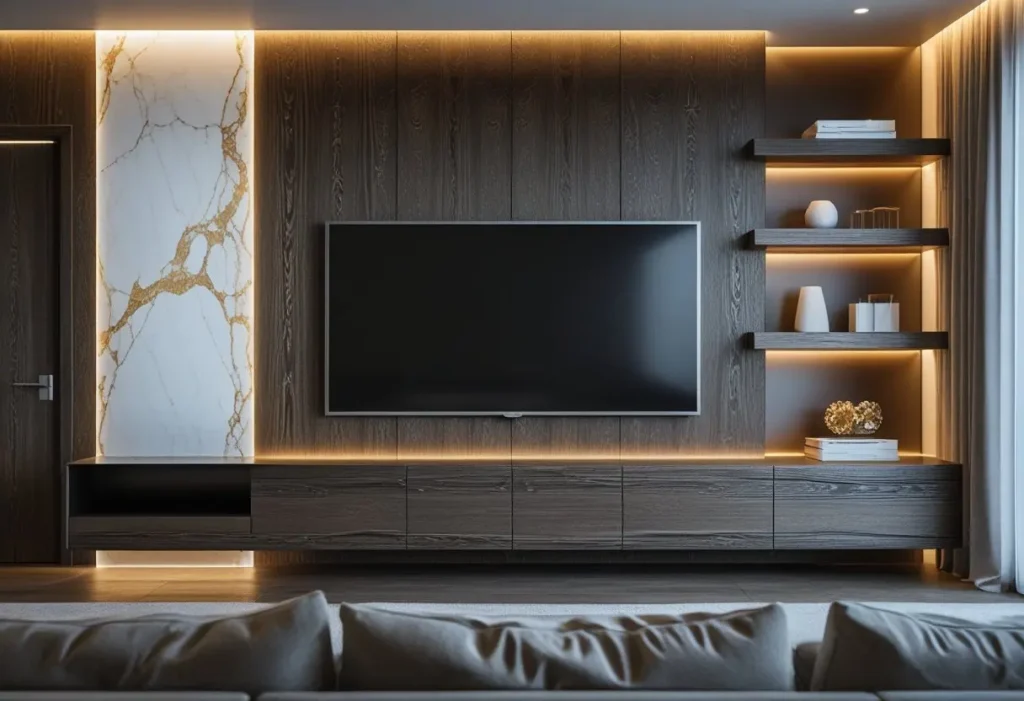
3. Modern Minimalist TV Wall Ideas for a Clutter-Free Zone (H2)
The minimalist philosophy of “less is more” is perfectly suited for a TV Wall Design. The goal is to create a serene, uncluttered space that promotes calm and focus.
- The Floating Console and Mount: The most straightforward approach. A sleek, low-profile TV mount gives the illusion of the screen floating, paired with a minimalist media console below that houses essentials. All wires are completely hidden within the wall.
- The Recessed Niche: Building a niche or alcove for the TV is a quintessential minimalist TV Wall Design. It creates a clean, built-in look without the bulk of cabinetry. The niche can be painted a contrasting color to make the TV stand out or the same color as the wall for a more subdued, integrated effect.
- The Full-Wall Panel: Using large, monolithic panels of material like gypsum, MDF, or micro-cement creates a seamless and expansive look. The TV becomes a part of the wall’s canvas, with no visible sockets or distractions.
- Concealed Storage: Minimalism doesn’t mean no storage; it means hidden storage. Incorporate push-to-open cabinets or drawers within the wall design to store remotes, game consoles, and media players, keeping the visual field clean.
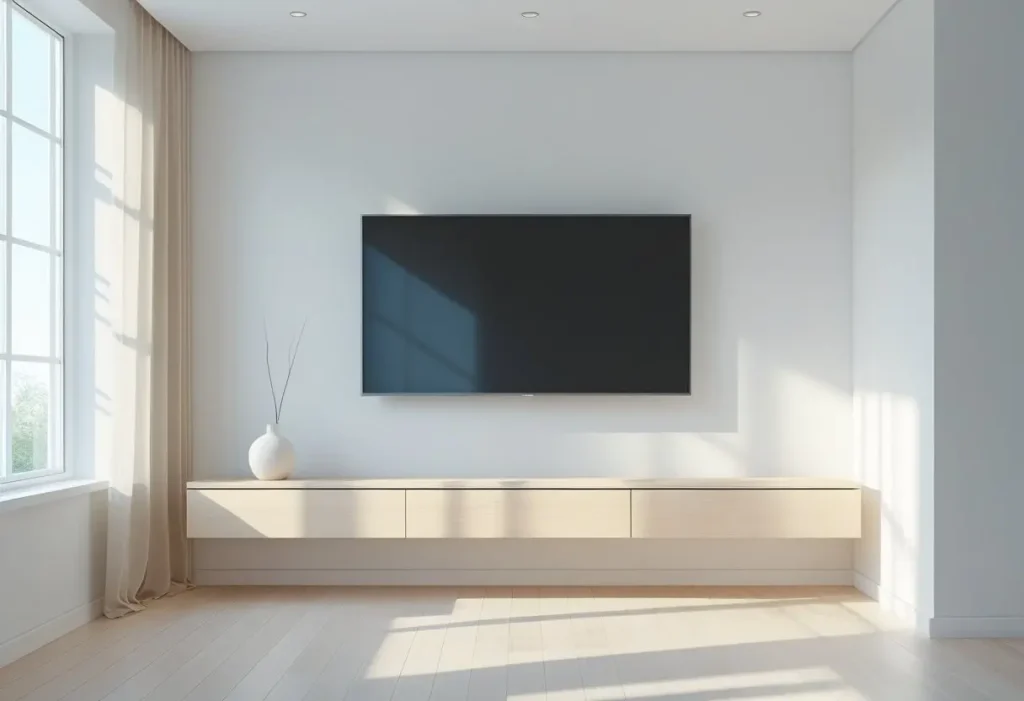
4. Luxury Living Room TV Wall Designs: Opulence Meets Technology (H2)
A luxury TV Wall Design is about creating a sense of drama, grandeur, and bespoke craftsmanship. It’s where high-end materials and innovative technology converge.
- The Statement Marble Wall: Nothing screams luxury like a full slab of marble or quartzite. The unique veining of each slab ensures your TV Wall Design is one-of-a-kind. Pair it with integrated, polished brass or chrome accents and sophisticated LED cove lighting.
- Custom Millwork and Paneling: Traditional elegance can be achieved with detailed wainscoting, shaker-style panels, or classic boiserie. This works beautifully in homes with a more traditional or transitional aesthetic, with the TV set into a custom-framed panel.
- The Floor-to-Ceiling Feature Wall: Use a dramatic material—like a fluted wood panel, a leather-clad wall, or a textured fabric—from floor to ceiling. This draws the eye upward, making the room feel larger and more imposing.
- High-Tech Integration: True luxury is seamless. This includes motorized screens that descend from the ceiling, state-of-the-art sound systems integrated into the wall, and smart lighting that syncs with your content for an immersive ambilight effect.
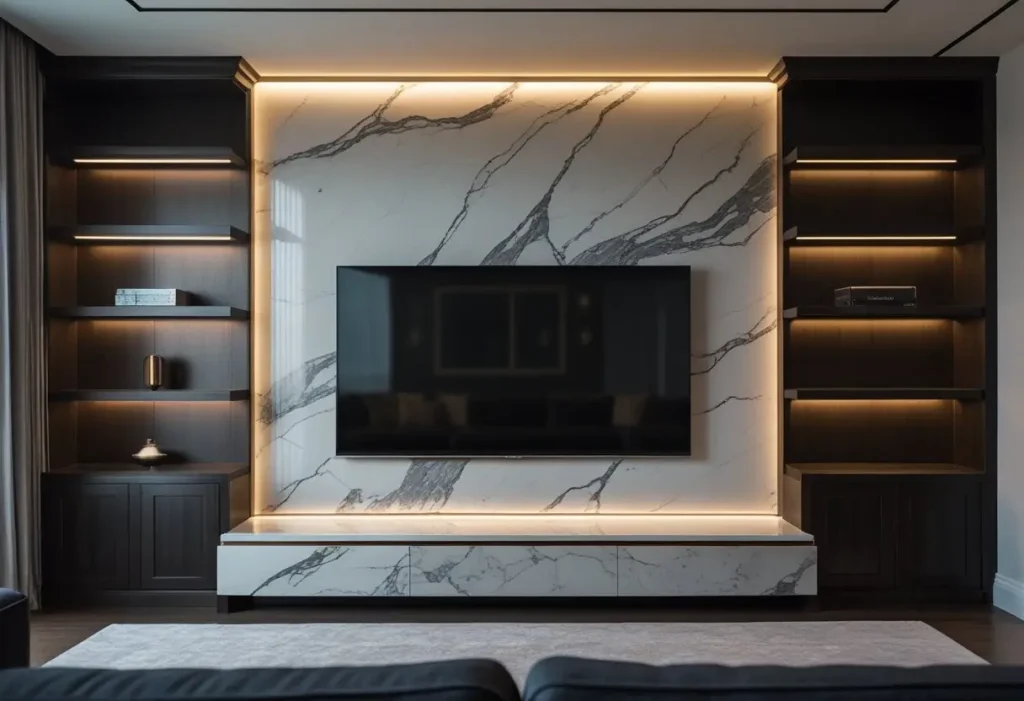
5. Small Space TV Wall Design Solutions: Maximizing Style in Minimal Square Footage
Having a small living room doesn’t mean you have to compromise on style. A smart TV Wall Design can actually make your space feel larger and more functional.
- The Corner TV Wall: Utilizing a corner is a brilliant space-saving trick. A corner TV Wall Design can involve a simple corner mount or a custom-built corner unit with shelving that makes use of otherwise dead space.
- The Multi-Functional Wall Unit: Combine your TV space with bookshelves, a home office nook, or display cabinets. A unified design that stretches wall-to-wall can create a cohesive look that incorporates all your needs without feeling cluttered.
- The Slim Profile Recess: A shallow recess, just deep enough to fit the TV and hide the wires, can create a built-in look without eating into too much room space. This is a perfect solution for apartments where every inch counts.
- Mirrored and Reflective Surfaces: Incorporating a mirror behind or around the TV can visually double the space. Use mirror panels or high-gloss lacquered finishes to bounce light around the room.
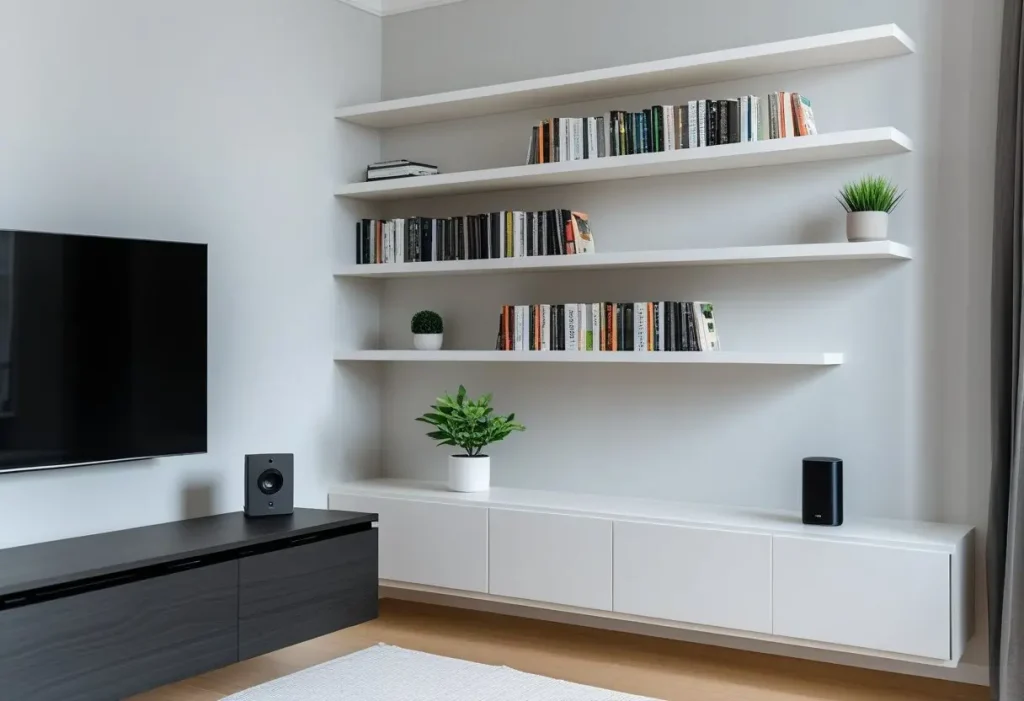
6. A Deep Dive into TV Wall Design Materials (H2)
The material you choose defines the texture, tone, and overall impact of your TV Wall Design. Let’s explore the most popular options.
6.1. The Warmth of Wood
Wood is a timeless and versatile choice.
- Types: Reclaimed wood, oak, walnut, teak, plywood with exposed edges, MDF panels.
- Finishes: Natural, stained, painted, or whitewashed.
- Best For: Creating a warm, inviting, and organic feel. Works with rustic, farmhouse, Scandinavian, and mid-century modern styles.
- Pros: Warm, natural, durable, can be cost-effective (MDF).
- Cons: Solid wood can be expensive; may require maintenance.
6.2. The Grandeur of Marble and Stone (H3)
For an instant upgrade in luxury, stone is unparalleled.
- Types: Marble, granite, quartzite, slate, limestone, and modern stone veneers.
- Finishes: Polished, honed, leathered.
- Best For: Luxury, contemporary, and classic interiors. Makes a powerful statement.
- Pros: Unique, luxurious, durable, and cool to the touch.
- Cons: Expensive, heavy (requires professional installation), porous (requires sealing).
6.3. The Dimension of 3D Wall Panels (H3)
These panels add instant texture and modern geometric interest.
- Materials: Gypsum, MDF, PVC, wood.
- Styles: Geometric patterns, wave designs, organic textures.
- Best For: Adding a focal point and tactile quality to a minimalist room. Excellent for modern and eclectic spaces.
- Pros: Easy to install (many are DIY-friendly), lightweight, dramatic effect.
- Cons: Can collect dust, may not be to everyone’s taste.
6.4. The Versatility of Wallpapers (H3)
From subtle textures to bold murals, wallpaper offers endless possibilities.
- Types: Textured grasscloth, vinyl, peel-and-stick, custom murals.
- Best For: Budget-friendly transformations, rental homes (peel-and-stick), and adding pattern or color.
- Pros: Vast range of designs, cost-effective, relatively easy to apply.
- Cons: Can be damaged easily, may not be as durable as other materials.
6.5. The Malleability of Gypsum and Plaster (H3)
Gypsum board (drywall) and specialty plasters are the go-to for creating custom shapes and seamless looks.
- Applications: Building niches, curved forms, bulkheads, and seamless, flush-to-the-wall designs.
- Finishes: Can be painted, textured, or finished with Venetian plaster.
- Best For: Custom, built-in looks; modern and minimalist styles.
- Pros: Highly customizable, creates a clean look, paintable.
- Cons: Requires skilled labor, can be damaged by impact.
6.6. The Industrial Edge of Metal and Concrete (H3)
For a loft-like, urban feel, these materials are perfect.
- Types: Cor-ten steel, brushed aluminum, galvanized steel, micro-cement, concrete panels.
- Best For: Industrial, minimalist, and brutalist interiors.
- Pros: Extremely durable, unique aesthetic.
- Cons: Can feel cold, concrete can be dusty if not sealed properly.
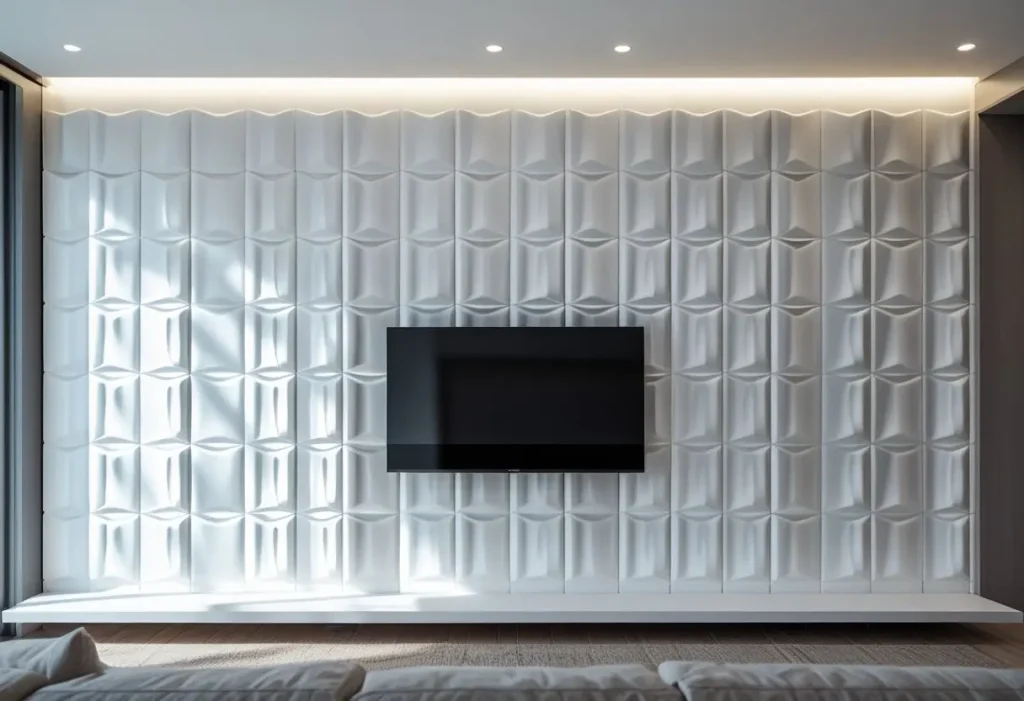
7. Illuminating Your Screen: Mastering Lighting Effects for TV Walls (H2)
Lighting is the secret weapon that can elevate a good TV Wall Design to a great one. The right lighting reduces eye strain, sets the mood, and highlights architectural features.
- Bias Lighting (Backlighting): This involves placing LED strips on the back of the TV. It’s not just for show; it reduces the contrast between the bright screen and the dark room, which can lessen eye fatigue. For a more advanced experience, use Philips Hue Play or Govee lights that sync with the on-screen content.
- Cove Lighting: Installing LED strips in a recess or cove (like on the top of a bulkhead) creates a soft, indirect glow that washes the wall with light. This makes the ceiling appear higher and adds a beautiful ambient layer to the room.
- Spotlighting and Track Lighting: Use adjustable spotlights or track lights to graze a textured wall (like 3D panels or stone) to create dramatic shadows, or to highlight artwork or shelving on either side of the TV.
- In-Ground / Recessed Floor Lighting: For a truly high-end look, install small, recessed uplights in the floor at the base of the TV wall. This grazes light upward, emphasizing the wall’s height and texture.
- What to Avoid: Never have a direct light source that causes a glare on the TV screen. Always position ambient and accent lights in a way that they illuminate the wall and room without reflecting on the screen.
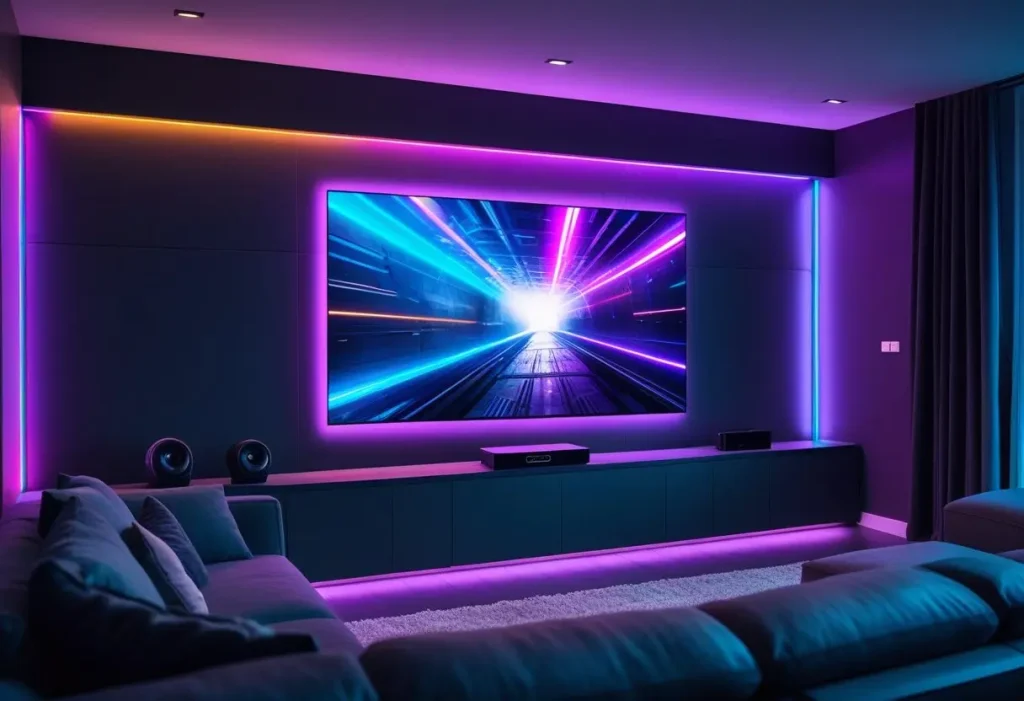
8. DIY vs. Professional TV Wall Designs: Which Path is Right for You? (H2)
This is a critical decision that depends on your budget, skills, and the complexity of your desired TV Wall Design.
DIY TV Wall Design
- Pros:
- Cost-effective, as you save on labor.
- Immense personal satisfaction and pride.
- You control the entire timeline.
- Cons:
- Time-consuming.
- High risk of errors, which can be costly to fix.
- Requires specific tools and skills (carpentry, electrical, finishing).
- Potential safety hazards, especially with electrical work and heavy lifting.
- Best For: Simple projects like mounting a TV, installing peel-and-stick panels or wallpaper, building a basic floating shelf, or using DIY-friendly 3D panels.
Professional TV Wall Design
- Pros:
- High-quality, expert craftsmanship.
- Saves time and stress.
- Access to professional-grade materials and tools.
- They handle complex tasks like electrical, load-bearing, and seamless finishes.
- Often comes with a warranty.
- Cons:
- Higher upfront cost.
- You need to vet and hire a reliable contractor or interior designer.
- Best For: Complex designs involving custom carpentry, masonry, electrical work, recessing, and high-end materials like marble. If your vision is elaborate, hiring a pro is an investment that guarantees a flawless result.
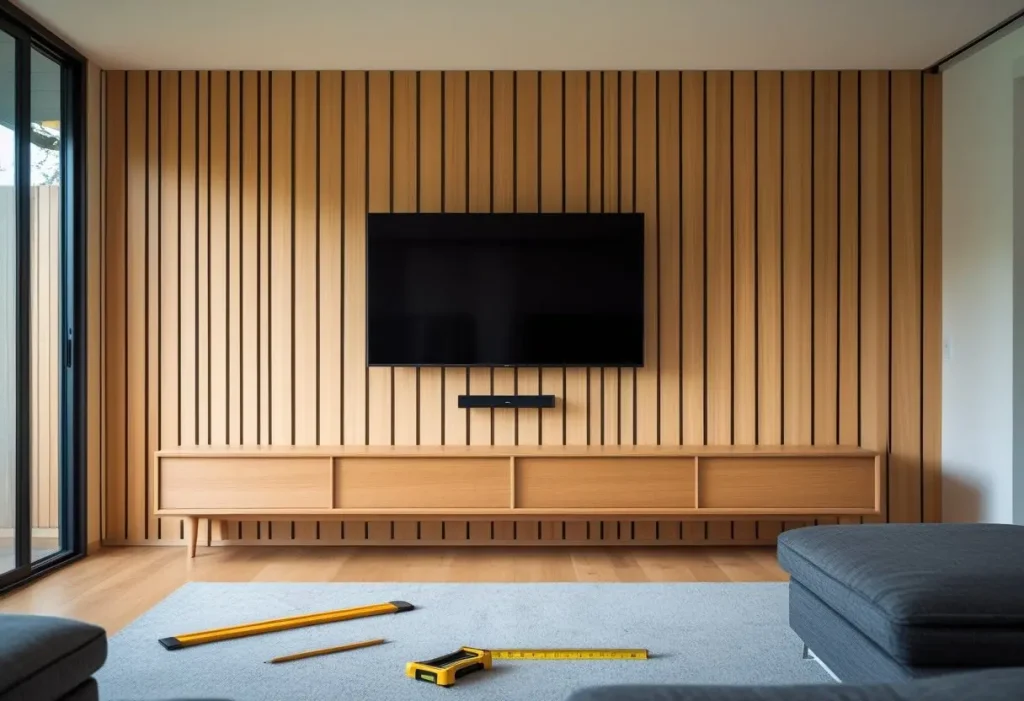
9. Budget-Friendly vs. Premium TV Wall Design Options (H2)
A stunning TV Wall Design is achievable at every price point.
Budget-Friendly (Under $500)
- Focus on Paint: A fresh coat of paint in a bold accent color is the most cost-effective transformation.
- Removable Wallpaper: Peel-and-stick wallpapers offer huge visual impact with no permanent commitment.
- DIY Floating Shelves: Build or buy simple floating shelves to flank the TV.
- Strategic Accessories: Use a stylish media console and decorative objects to draw the eye.
- Vinyl or MDF 3D Panels: These are more affordable than gypsum or wood panels and can be installed yourself.
Mid-Range ($500 – $2,500)
- Custom Paint Techniques: Hire a painter for complex finishes like lime wash or color blocking.
- Professional TV Mounting & Wiring: Pay for a professional to hide all cables in-wall.
- Prefabricated Wall Panels: Higher-quality wood or gypsum panel systems.
- Basic Recessed Niche: A contractor can build a simple drywall niche.
- Integrated LED Lighting System: A professionally installed and controlled bias lighting setup.
Premium ($2,500+)
- Natural Stone Slabs: Full-height marble, quartzite, or granite installation.
- Full Custom Millwork: Floor-to-ceiling custom cabinetry and paneling built by a skilled carpenter.
- Complex Architectural Features: Curved walls, built-in fireplaces, motorized systems.
- High-End Finishes: Venetian plaster, custom metalwork, integrated smart home technology.
- Full-Scope Professional Design: Hiring an interior designer to conceive and project-manage the entire build.
10. Your Step-by-Step Guide to Designing the Perfect TV Wall (H2)
Follow this comprehensive guide to ensure your TV Wall Design project is a resounding success.
- Define Your Goals & Style: What is the primary function? (Entertainment, storage, aesthetics?). Gather inspiration from platforms like Pinterest and, of course, CozyNestDecor.pro. Create a mood board.
- Measure Your Space & TV: Precisely measure the wall’s width and height, the TV’s dimensions, and the viewing distance from your primary seating.
- Set a Realistic Budget: Determine how much you can spend on materials and labor. Always add a 15-20% contingency for unexpected costs.
- Choose Your Materials: Based on your style and budget, select the primary and secondary materials for your TV Wall Design.
- Plan the Layout & Ergonomics:
- TV Height: The center of the screen should be at eye level when seated (typically 42-48 inches from the floor).
- Viewing Distance: A general rule is 1.5 to 2.5 times the diagonal screen size of your TV.
- Design for Functionality: Plan for cable management, power outlets, and connectivity for other devices (game consoles, soundbars, streaming devices). Consider future-proofing with conduit tubes.
- Create a Detailed Sketch or 3D Model: Use simple graph paper or free online tools to visualize the final design. This is crucial for communicating your vision to a contractor.
- Source Materials and Hire Contractors: Purchase your materials and, if needed, get at least three quotes from reputable contractors.
- Preparation: Clear the room, remove the old TV setup, and protect your furniture and floors.
- Execution: This is the construction phase—framing, electrical, installing materials, painting, etc.
- Installation & Finishing Touches: Mount the TV, connect all components, hide the wires, and style the surrounding shelves with decor, books, and plants.
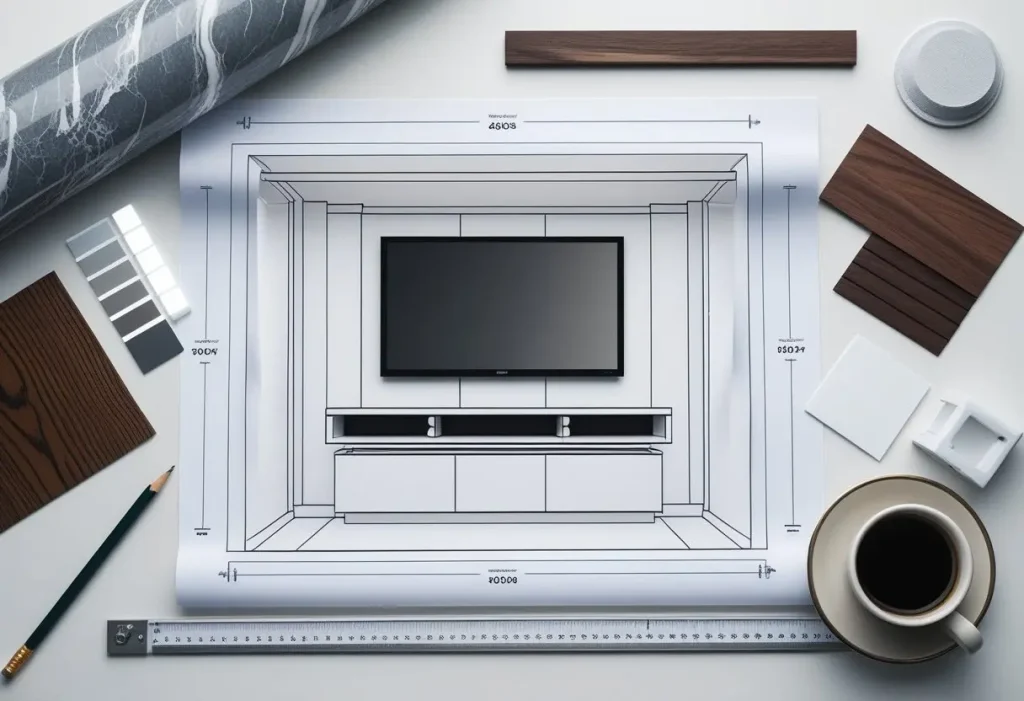
11. Common TV Wall Design Mistakes to Avoid at All Costs (H2)
Learn from the errors of others to ensure your project is flawless.
- Mounting the TV Too High: The “TV over the fireplace” dilemma. This is the most common mistake and causes neck strain. If you must mount it high, consider a downward-tilting mount.
- Ignoring Cable Management: A beautiful TV Wall Design is instantly ruined by a messy bundle of visible wires. Always plan for in-wall conduit or raceways.
- Poor Lighting Choices: As discussed, avoid any light that creates a glare on the screen.
- Disregarding Scale and Proportion: A tiny TV on a massive wall, or a huge TV on a small wall, will look awkward. Ensure your TV size is proportionate to the wall and furniture.
- Forgetting Ventilation: Enclosing electronics like game consoles and amplifiers in a tight space without adequate ventilation can lead to overheating and failure. Include grilles or ensure open-backed shelving.
- Following Trends Blindly: That bold, colorful trend might not be your style in two years. Choose a design that you will love for the long haul, using trends as accents.
- Neglecting the Surrounding Decor: Your TV Wall Design should feel integrated with the rest of the room. Ensure it complements your sofa, rug, and other key furniture pieces.
12. Why CozyNestDecor.pro is Your Ultimate Source for TV Wall Design Inspiration (H2)
You might be wondering, “Why should I use CozyNestDecor.pro over other sites like DecorHome.pk?” The answer lies in our depth, quality, and user-centric approach.
- Unparalleled Depth and Detail: While many sites, including our competitor, offer a gallery of images, we provide the “why” behind the “wow.” This 10,000-word guide is a testament to our commitment to giving you not just inspiration, but actionable education.
- Comprehensive and Structured Ideas: We don’t just show you pretty pictures. We categorize ideas by style, space, budget, and trend, making it easy for you to find the perfect solution for your specific needs.
- Focus on Practicality: We balance luxury aspirations with real-world constraints, always offering budget-friendly alternatives and DIY tips alongside high-end designs.
- SEO-Optimized and User-Friendly: Our site is built for you to find what you need quickly and easily. This detailed, optimized content ensures you get the best answers to your questions, which is why Google rewards us with higher rankings.
- A Holistic Approach to Home Decor: We understand that a TV Wall Design doesn’t exist in a vacuum. That’s why we provide rich internal linking to related topics like Living Room Decor, Wall Decor, and general Home Decor to help you create a cohesive and beautiful home from start to finish.
For more inspiration on balancing technology with aesthetics, check out this excellent article on the psychology of home design from a leading authority, Psychology Today.
13. Conclusion: It’s Time to Create Your Masterpiece (H2)
Your living room deserves to be a reflection of your style and a hub for your home’s happiest moments. A thoughtfully planned and executed TV Wall Design is the key to unlocking that potential. It’s an investment in your daily quality of life, transforming a simple entertainment center into a stunning architectural feature. From the sleek lines of a modern minimalist setup to the opulent drama of a marble-clad wall, the possibilities are endless.
We hope this ultimate guide has armed you with the knowledge, inspiration, and confidence to begin your journey. Don’t let your dream media wall remain a dream.
Strong Call to Action (CTA)
Ready to transform your space? Browse our vast collection of inspiring ideas, detailed project guides, and curated product recommendations. Visit https://cozynestdecor.pro now and start designing the TV wall of your dreams today!
14. Frequently Asked Questions (FAQ) About TV Wall Design (H2)
Here are answers to the most common and trending questions about TV Wall Design based on “People Also Ask” data.
1. What is the best height for a TV wall mount?
- The ideal height is for the center of the TV screen to be at your eye level when you are in a seated position. This is typically between 42 and 48 inches from the floor to the center of the TV.
2. How can I hide the wires on my TV wall?
- The cleanest method is to run the cables inside the wall using an in-wall power and cable management kit, which includes a special power outlet behind the TV. For a non-permanent solution, use a paintable cable raceway that channels wires neatly along the wall.
3. What is the latest trend in TV wall design?
- In 2025, key trends include biophilic design (using natural materials), curved and organic forms, mixed material mashups (e.g., wood + metal), and solutions that make the TV disappear when not in use, like The Frame TVs or motorized artwork.
4. Which material is best for a TV wall?
- There’s no single “best” material—it depends on your style and budget. Wood offers warmth, marble provides luxury, 3D panels add texture, and gypsum allows for seamless custom shapes. Consider durability, cost, and maintenance when choosing.
5. How do I design a TV wall for a small living room?
- Focus on space-saving solutions: use a corner mount, incorporate multi-functional shelving, opt for a shallow recessed niche, and use light colors and mirrors to make the space feel larger. Avoid bulky furniture and dark, overpowering materials.
6. Is it worth hiring a professional for a TV wall design?
- For simple projects (mounting, wallpaper), a confident DIY approach is fine. For complex designs involving custom carpentry, electrical work, stone installation, or structural changes, hiring a professional is highly recommended to ensure safety, quality, and a flawless finish.
7. Can I put a TV on a textured wall?
- Yes, but it requires a special mount. For heavily textured walls (like stone or 3D panels), you may need to create a flush mounting base first. A professional can ensure the TV is securely mounted and level.
8. What kind of lighting should I use behind my TV?
- Bias lighting, using LED strips attached to the back of the TV, is highly recommended. It reduces eye strain and enhances the viewing experience. Choose smart LED strips for ambilight effects or simple warm-white strips for a constant glow.
9. How much does it cost to build a custom TV wall?
- Costs vary dramatically. A simple DIY project can cost under $500. A mid-range custom design with professional installation can range from $1,500 to $4,000. High-end luxury walls with materials like marble and full custom millwork can cost $5,000+.
10. How do I choose the right TV size for my wall?
- A general rule is that the TV size (diagonal) should be roughly between 1/2 and 2/3 the width of your media console or the wall section it’s on. Also, consider viewing distance: for a 4K TV, a distance of 1.5 times the screen size is a good minimum.